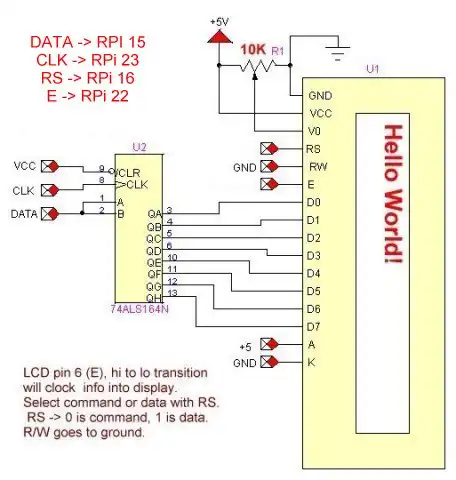
Raspberry Pi 74164 Serial Shift Register Interface Liquid Crystal Display
Here we connect my serial LCD display circuit to the Raspberry Pi. This saves the use of GPIO pins for other uses. The routines are as follows:
pulseCLK() used to clock data into the SN74164.
pulseE() shifts the parallel data in the display. The RS pin determines if the data is a command/address or ASCII code.
ssrWrite(int) uses a "for" loop with pulsCLK() to shift 8-data into the SN74164.
initLCD(), clearLCD(), and Home() are used to setup the operation of the LCD display. They set RS LOW for command mode, use ssrWrite() to clock byte into 74164, the use pulseE() to enter parallel data into display control circuits.
gotoLocation(address) inputs an address in the internal ram of the display at a select location for display. 0x80 is column 0, line 0 (first character line 1) and 0xC0 is column 0 line 1 (first character line 2).
wrtiteString(text-string) is used with the above functions to write an ASCII string to the display. This must proceeded by gotoLocation(address) to set the position pointer in the display for the text.
convBinary(value) is used to convert an 8-bit number to an ASCII string of 1s and 0s. It doesn't drop leading 0s like the python bin(x) function does.
The complete code is rpi_arduino2.txt.
Click for picture RPi 2 GPIO pin connections.
- Software and setup:
- Raspberry Pi Openbox Desktop 2019
- Setting up Openbox for Raspberry Pi
- WiringPi and Pulse-Width-Modulation with Raspberry Pi
- WiringPi for Raspberry Pi and MAX6675 thermal-couple sensor
- WiringPi Blink an LED Demo
- Interface I2C LCD to Raspberry Pi in C
- ADS1115 4-Channel ADC Uses I2C with Raspberry Pi
- MCP4725 12-Bit DAC Interface to Raspberry Pi
- Raspberry Pi with PCF8591 Analog To Digital Control in C
- Raspberry Pi PCF8591 AD-DA Sensor Python Interface
This is a collection of programs and hardware hacks related to mainly Raspberry Pi and Debian Linux.
- Main Light Fast Linux Desktops with Openbox, JWM
- Test Reuse Surplus PC Power Supplies
- Add WBAR Launch Dock to Raspberry Pi
- Add MPG123 Terminal Music Player to Raspberry Pi, Linux
- Basics of Alsamixer Audio Control for Linux
- Add Solid State Hard Drive to Raspberry Pi
- Beep a PC Speaker Add Beeper to Raspberry Pi
- Using FEH Wallpaper Setter Under Linux
- Scrot Lite Weight Screen Shot Software for Linux
- Using Light Weight Beaver Text Editor
- Install Viewnior Image Viewer for Linux
- Zmixer ALSA Sound Control Tutorial
- Tutorial Xinitrc Desktop Manager Control for Linux
- Setup Raspberry Pi Using JWM Window Manager
Web site Copyright Lewis Loflin, All rights reserved.
If using this material on another site, please provide a link back to my site.